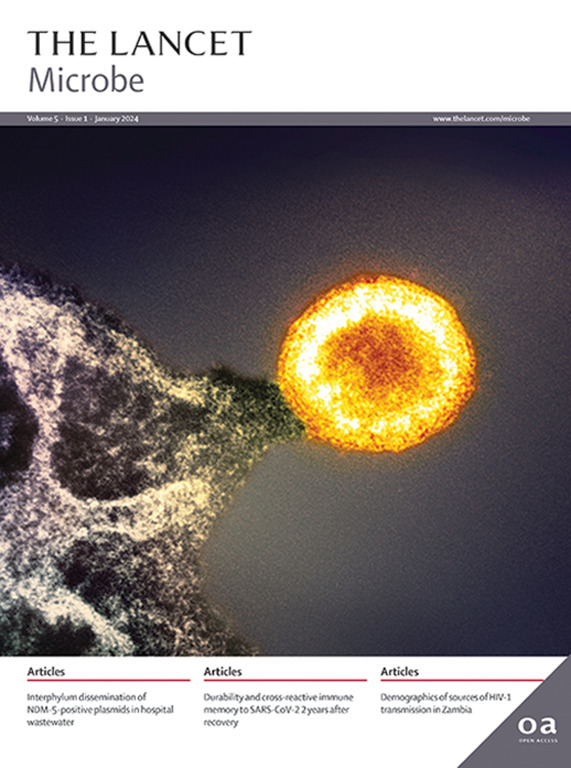Evaluation of a point-of-care immunochromatographic assay for enteric fever in Dhaka, Bangladesh: a prospective diagnostic accuracy study
IF 20.9
1区 生物学
Q1 INFECTIOUS DISEASES
引用次数: 0
Abstract
Background
There is a shortage of rapid, accurate, and low-cost assays for diagnosing enteric fever. The dual-path platform for typhoid (DPPT) assay had high accuracy in retrospective studies with banked plasma samples. We aimed to evaluate the diagnostic accuracy of the DPPT assay in a prospective study using fingerstick capillary blood.
Methods
For this prospective diagnostic accuracy study, we enrolled children younger than 18 years, who presented at the Bangladesh Shishu Hospital and Institute (Dhaka, Bangladesh) with at least 3 days of fever. We collected blood and nasal swabs, and did the following assays to assess the accuracy of DPPT: blood culture, serological assays for typhoid fever (DPPT assay, Widal, and Test-it), and molecular assays to identify alternative aetiologies (eg, respiratory syncytial virus [RSV], influenza, dengue virus, and Rickettsia spp). The primary outcomes of the study were the sensitivity and specificity of the DPPT assay for diagnosis of enteric fever. We evaluated the accuracy of combined anti-haemolysin E and anti-lipopolysaccharide IgA readings using the DPPT assay in distinguishing culture-confirmed enteric fever from alternative aetiologies using receiver operating characteristic area under the curve (AUC). Given the imperfect reference standard diagnostics for enteric fever, we used Bayesian latent class models, incorporating results from the typhoid and alternative aetiology diagnostics, to estimate the sensitivity and specificity of the DPPT assay. We also did subgroup analyses for the assay across multiple biological variables.
Findings
Between Aug 17, 2021, and July 16, 2022, we enrolled 501 participants who presented with at least 3 days of fever. 223 (45%) of 501 participants were female and 278 (55%) were male. 77 participants had culture-confirmed enteric fever (62 Salmonella enterica serotype Typhi and 15 Salmonella enterica serotype Paratyphi A) and 70 were culture-negative with PCR-confirmed alternative aetiology (34 influenza A or B, 22 dengue virus, seven Rickettsia spp, six RSV, and one participant co-infected with RSV and dengue virus). The AUC for DPPT on fingerstick capillary blood in distinguishing typhoid from alternative aetiologies was 0·969 (95% CI 0·943–0·994). In latent class analysis, the sensitivity of DPPT was 93% (95% credible interval [CrI] 87–97) and specificity was 89% (85–93). The balanced accuracy was higher for DPPT (91%, 95% CrI 87–94) than blood culture (81%, 78–85), Test-it (77%, 74–79), or Widal (70%, 67–73). Assay performance did not vary by sex, age, duration of fever at presentation, antibiotic use before presentation, Salmonella serotype, or sample type.
Interpretation
The point-of-care DPPT assay achieved high diagnostic accuracy for enteric fever in a highly endemic community. This assay has the potential to improve clinical outcomes for enteric fever, allowing rapid diagnosis and treatment, and could facilitate more appropriate antimicrobial use.
Funding
National Institute of Health, Bill & Melinda Gates Foundation, and Child Health Research Foundation.
在孟加拉国达卡评估肠道热的护理点免疫层析检测法:前瞻性诊断准确性研究。
背景:目前缺乏快速、准确、低成本的诊断肠热病的检测方法。伤寒双路检测平台(DPPT)在回顾性研究中具有较高的准确性。我们的目的是评估DPPT分析的诊断准确性在一项前瞻性研究中使用手指刺毛细管血。方法:在这项前瞻性诊断准确性研究中,我们招募了年龄小于18岁的儿童,他们在孟加拉国Shishu医院和研究所(Dhaka, Bangladesh)出现至少3天的发烧。我们采集了血液和鼻拭子,并进行了以下检测来评估DPPT的准确性:血液培养、伤寒血清学检测(DPPT检测、Widal检测和测试-it检测),以及分子检测以确定其他病因(如呼吸道合胞病毒[RSV]、流感、登革热病毒和立克次体)。该研究的主要结果是DPPT检测诊断肠热的敏感性和特异性。我们利用受试者曲线下工作特征面积(AUC),评估了DPPT检测联合抗溶血素E和抗脂多糖IgA读数在区分培养证实的肠热病和其他病因方面的准确性。考虑到肠热诊断的参考标准不完善,我们使用贝叶斯潜类模型,结合伤寒和其他病因学诊断的结果,来估计DPPT检测的敏感性和特异性。我们还对该试验进行了跨多个生物变量的亚组分析。研究结果:在2021年8月17日至2022年7月16日期间,我们招募了501名至少发烧3天的参与者。在501名参与者中,223名(45%)是女性,278名(55%)是男性。77名参与者有培养证实的肠道发热(62名伤寒沙门氏菌血清型和15名甲型副伤寒沙门氏菌血清型),70名培养阴性,pcr确认的其他病因(34名甲型或乙型流感,22名登革热病毒,7名立克次体,6名RSV和1名合并感染RSV和登革热病毒的参与者)。指检毛细血管血DPPT鉴别伤寒与其他病因的AUC为0.969 (95% CI为0.943 ~ 0.994)。在潜在分类分析中,DPPT的敏感性为93%(95%可信区间[CrI] 87-97),特异性为89%(85-93)。DPPT的平衡准确度(91%,95% CrI 87-94)高于血培养(81%,78-85)、Test-it(77%, 74-79)或Widal(70%, 67-73)。检测结果不受性别、年龄、发病时发热持续时间、发病前抗生素使用、沙门氏菌血清型或样本类型的影响。解释:在一个高度流行的社区,即时护理DPPT检测对肠热病的诊断具有很高的准确性。这种检测方法有可能改善肠热病的临床结果,允许快速诊断和治疗,并可能促进更适当的抗菌药物使用。资助:美国国立卫生研究院、比尔及梅琳达·盖茨基金会和儿童健康研究基金会。
本文章由计算机程序翻译,如有差异,请以英文原文为准。
求助全文
约1分钟内获得全文
求助全文
来源期刊

Lancet Microbe
Multiple-
CiteScore
27.20
自引率
0.80%
发文量
278
审稿时长
6 weeks
期刊介绍:
The Lancet Microbe is a gold open access journal committed to publishing content relevant to clinical microbiologists worldwide, with a focus on studies that advance clinical understanding, challenge the status quo, and advocate change in health policy.
 求助内容:
求助内容: 应助结果提醒方式:
应助结果提醒方式:


